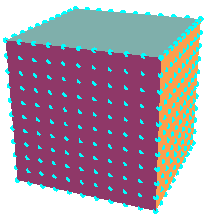where a φ indicates temperature, a k is the conductivity and a Q is the heat generation per unit volume and Ω is the domain of the problem.
In the section Description of Introductory Example the description of the steady-state heat conduction on a three-dimensional domain was given. The solution of the same physical problem can be obtained also as a minimum of the free energy of the problem. Free energy of the heat conduction problem can be formulated as![]()
where a φ indicates temperature, a k is the conductivity and a Q is the heat generation per unit volume and Ω is the domain of the problem.
The domain of the example is a cube filled with water ([-.0.5m,0.5m]×[-0.5m,0.5m]×[0,1m]). On all sides, apart from the upper surface, the constant temperature φ=0 is maintained. The upper surface is isolated so that there is no heat flow over the boundary. There exists a constant heat source Q=500 ![]() inside the cube. The thermal conductivity of water is 0.58 W/m K. The task is to calculate the temperature distribution inside the cube.
inside the cube. The thermal conductivity of water is 0.58 W/m K. The task is to calculate the temperature distribution inside the cube.

The problem is formulated using various approaches:
A. Trial polynomial interpolation
M.G Gradient method of optimization + Mathematica directly
M.N Newton method of optimization + Mathematica directly
A.G Gradient method of optimization + AceGen+MathLink
A.N Newton method of optimization + AceGen+MathLink
B. Finite difference interpolation
M.G Gradient method of optimization + Mathematica directly
M.N Newton method of optimization + Mathematica directly
A.G Gradient method of optimization + AceGen+MathLink
A.N Newton method of optimization + AceGen+MathLink
C.AceFEM Finite element method
The following quantities are compared:
• temperature at the central point of the cube (φ(0.,0.,0.5))
• time for derivation of the equations
• time for solution of the optimization problem
• number of unknown parameters used to discretize the problem
• peak memory allocated during the analysis
• number of evaluations of function, gradient and hessian.
Method
mesh
φ
derivation
time(s)solution
time (s)No. of variables
memory (MB)
No. of calls
A.MMA.Gradient
5×5×5
55.9
8.6
56.0
80
136
964
A.MMA.Newton
5×5×5
55.9
8.6
2588.3
80
1050
4
A.AceGen.Gradient
5×5×5
55.9
6.8
3.3
80
4
962
A.AceGen.Newton
5×5×5
55.9
13.0
0.8
80
4
4
B.MMA.Gradient
11×11×11
57.5
0.3
387.5
810
10
1685
B.MMA.Newton
11×11×11
57.5
0.3
4.2
810
16
4
B.AceGen.Gradient
11×11×11
57.5
1.4
28.16
810
4
1598
B.AceGen.Newton
11×11×11
57.5
4.0
1.98
810
4
4
C.AceFEM
10×10×10
56.5
5.0
2.0
810
6
2
C.AceFEM
20×20×20
55.9
5.0
3.2
7220
32
2
C.AceFEM
30×30×30
55.9
5.0
16.8
25230
139
2
The case A with the trial polynomial interpolation represents the situation where the merit function is complicated and the number of parameters is small. The case B with the finite difference interpolation represents the situation where the merit function is simple and the number of parameters is large.
REMMARK: The presented example is meant to illustrate the general symbolic approach to minimization of complicated merit functions and is not the state of the art solution of thermal conduction problem.
| Created by Wolfram Mathematica 6.0 (13 August 2007) |